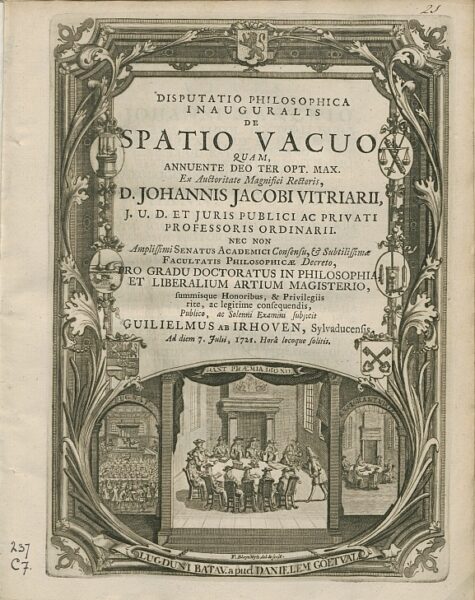
An engraving of the circa 1715 PhD ceremony at Leiden University illustrates the cover of a dissertation. Wikimedia Commons
In October, the AHA Council approved Guidelines for the Doctoral Dissertation Process, outlining the shared responsibilities of students and faculty involved in graduate education. The guidelines offer a common language and describe a basic structure of the dissertation process that students and faculty can refer to during each individualized process. Philippa Levine, AHA vice president, Professional Division, and professor of history at the University of Texas at Austin, says the goal in drafting the new guidelines was to “provide a flexible road map that would help both students and those who advise them manage an important process without delaying the student’s progress or unduly burdening already busy faculty.”
The AHA’s guidelines complement widely varying institutional frameworks with a statement of recommended practices for managing the relationships and work patterns that nurture a dissertation. Levine says the Professional Division recognized that the “main challenge in crafting the guidelines was taking into account the varied landscape in doctoral programs around the country.” Anita Casavantes Bradford, associate professor of history at the University of California, Irvine, and chair of the AHA’s Graduate and Early Career Committee, says it is important that graduate students have “a consistent, purposeful, and transparent set of expectations and procedures for completing their dissertation. The new guidelines are a great resource for faculty and grad students alike.”
The guidelines recognize that dissertation advising is “a highly specialized form of teaching,” and the dissertation process has “distinct phases” with “distinct responsibilities” for the doctoral student, the faculty adviser, and members of the dissertation committee. The document offers suggestions for faculty involvement at each step, from advising the student on an appropriate thesis topic, to the proper and sensible use of archival materials, to timelines for feedback on draft chapters. Nancy Reynolds, associate professor of history and director of graduate studies at Washington University in St. Louis, says that “having a standardized set of guidelines helps students know what to expect in terms of faculty participation in the dissertation process.” The guidelines also articulate the basic standards that a dissertation must reach, while leaving the precise evaluation of this standard to faculty advisers and dissertation committee members. These brief guidelines outline the essential features of a dissertation as a writing project and the collaborative process of its creation. Katie Streit, who received her PhD in history from the University of Houston in 2016, finds that the guidelines “can serve as an important reference point for students who are beginning their dissertation and are anxious about what the process entails.”
In addition to providing a reference point for a typical process, the document outlines ways to handle different scenarios that could arise, such as finding a replacement when a faculty member becomes unable to serve on the committee and how to handle a sabbatical leave. The guidelines also provide points that should be clarified, such as “whether [committee members] will be willing to read draft chapters” and “how far in advance [committee members] require the materials necessary for writing recommendations.” Faculty and students can use these guidelines to structure their timeline for completion. Streit thinks the guidelines will “empower students to speak confidently with their adviser/committee about their dissertation plan and the guidance they need moving forward.” As a flexible document, says Reynolds, the guidelines are “a tool for students to advocate for the support they need in the process. This is crucial given the wide variability of advising relationships in graduate programs.” At the same time, the guidelines assist “directors of graduate programs and faculty advisers in establishing a more uniform experience in a critical phase of graduate training.” The guidelines can serve at a departmental level to evaluate a department’s policies and expectations alongside a third-party standard.
Guidelines for the Doctoral Dissertation Process was released as part of the AHA’s mission to establish standards and support the work of historians at all levels. The document joins other guidelines and statements related to graduate education, on issues ranging from graduate school offers of financial support to hiring processes and empowering students to make decisions about disseminating their completed dissertations.
This work is licensed under a Creative Commons Attribution-NonCommercial-NoDerivatives 4.0 International License. Attribution must provide author name, article title, Perspectives on History, date of publication, and a link to this page. This license applies only to the article, not to text or images used here by permission.



